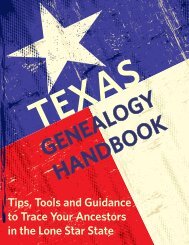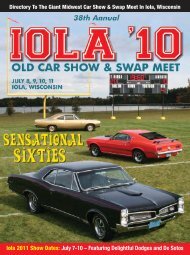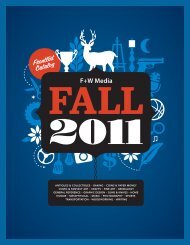Blue Ribbon Entries1965 Chevrolet Corvette Coupe . . . . . . . . . . . . . . . . . . . Scheidt, Ken1965 Chevrolet Chevelle Malibu SS (Crocus Yel. . . . . . . . . . . . . . . . . . . . . . . . . . . . . . . . . . . .Schenkenberg, Rick1962 Chevrolet Impala SS 2 DR HT . . . . . . . . . . . . . . . . . . Schill, Bill1966 Chevrolet Impala Convertible . . . . . . . . . . . . . . . . Schlag, Jack1956 Ford Thunderbird Convertible . . . . . . . . . . . Schmieden, Harley1941 Chevrolet Special Deluxe 6 Cyl . . . . . . . . . . . . . . . . Schmit, Lee1963 Chevrolet Impala 409 2 DR SS . . . . . . . . .Schneider, Rich/Barb1969 Ford Mustang Fastback . . . . . . . . . . . . . . . . . . Schrader, James1911 Ford Model T . . . . . . . . . . . . . . . . . . . . . . . . . . Schreiber, Glenn1929 Chevrolet Sedan 4 DR . . . . . . . . . . . . . . . . . . . Schreiber, Glenn1961 Chevrolet Impala 2 DR HT . . . . . . . . . . . . . . . Schuh, Ron/Susie1931 Chevrolet Special Sedan . . . . . . . . . . . . . . . . . . . .Schulfer, Dan1974 Cadillac Eldorado Convertible . . . . . . . . . . . . . . . .Schulfer, Dan1957 Ford T-Bird . . . . . . . . . . . . . . . . . . . . . . . . . . . . . . Scott, Robert1963 Studebaker GT Hawk Coupe . . . . . . . . . . . . . . . . Seering, Scott1964 Studebaker Avanti . . . . . . . . . . . . . . . . . . . . . . . . Seering, Scott1958 <strong>Old</strong>smobile Super 88 HT . . . . . . . . . . . . . . . . . . . . . Servais, Ed1953 Buick Super Riviera 2 DR HT . . . . . . . . . . . . . . Seymer, Gerald1959 Rambler Custom . . . . . . . . . . . . . . . . . . . . . . . . . . Shaw, Sigrid1957 Chevrolet Nomad . . . . . . . . . . . . . . . . . . . . . . Shea, John/Mary1964 Pontiac Bonneville Conv . . . . . . . . . . . . . . . . . . . . .Sieber, John1975 Pontiac Grandville . . . . . . . . . . . . . . . . . . . . . . . . . .Sieber, John1954 Chevrolet 210 Delray Club Coupe . . . . . . . . . .Simonson, Bryan1964 Buick Lesabre 4 DR HT . . . . . . . . . . . . . . . . . .Simonson, Bryan1956 Pontiac Starchief . . . . . . . . . . . . . . . . . . . . . Simonson, Dolores1950 Pontiac Chieftain Silver Streak . . . . . . . . .Sipiorski, Gary/Linda1967 Chevrolet Impala SS . . . . . . . . . . . . . . . . .Sipiorski, Gary/Linda1959 Ford Station Wagon . . . . . . . . . . . . . . . . . . . . . . . .Slusar, John1955 Chevrolet Belair . . . . . . . . . . . . . . . . . . . . . . . . . . . Smith, David1962 Chevrolet Corvette . . . . . . . . . . . . . . . . . . . . . . . . Smith, David1958 Chevrolet Corvette Conv . . . . . . . . . . . . . . . . . . . . Smith, Peter1956 Chevrolet Corvette Conv . . . . . . . . . . . . . . . . . . . . Smith, Victor1960 Chevrolet Corvette Conv . . . . . . . . . . . . . . . . . . . . Smith, Victor1960 Chevrolet Corvette . . . . . . . . . . . . . . . . . . . . .Sommer, Richard1968 Ford Shelby Mustang GT 350 . . . . . . . . . . . . . . . Spaude, Mark1954 Lincoln Capri Coupe . . . . . . . . . . . . . . . . . . . . . . . Staehle, Dan1966 Pontiac GTO HT . . . . . . . . . . . . . . . . . . . . . . . . . . Staehle, Dan1930 Ford A 4 DR . . . . . . . . . . . . . . . . . . . . . . . . . . . . . Staehle, Jack1929 Ford Station Wagon . . . . . . . . . . . . . . . . . . . Steinfeldt, Eugene1930 Ford Pick Up . . . . . . . . . . . . . . . . . . . . . . . . . Steinfeldt, Eugene1931 Ford Coupe . . . . . . . . . . . . . . . . . . . . . . . . . . Steinfeldt, Eugene1966 Ford Mustang Conv . . . . . . . . . . . . . . . . . . . . . . . . Steinke, <strong>Car</strong>l1959 Chevrolet Impala 2 DR HT . . . . . . . . . . . . . . . . . . Steinke, Peter1964 Chevrolet Corvette Coupe . . . . . . . . . . . . . . . . . . . Stintzi, John1966 Ford Thunderbird Convertible . . . . . . . . . . . . . . . . Storm, Dave1931 Buick . . . . . . . . . . . . . . . . . . . . . . . . . . . . . . . . . . Straub, Chuck1931 Ford Model A . . . . . . . . . . . . . . . . . . . . . . . . . . . Straub, Chuck1930 Ford Model A Fordor . . . . . . . . . . . . . . . . . . . . .Straub, Thomas1956 Chevrolet . . . . . . . . . . . . . . . . . . . . . . . . . . . . . . . . .Suehring, Al1961 Chevrolet Corvair . . . . . . . . . . . . . . . . . . . . . . . . . .Suehring, Al1953 Mercury Monteroy Conv . . . . . . . . . . . . . Suhsen, Larry/Twylah1956 Chevrolet Belair Conv . . . . . . . . . . . . . . . . . . Sustman, Bernard1967 <strong>Old</strong>smobile Cutlass HT . . . . . . . . . . . . . . . . . Sustman, Richard1924 Buick Touring Sedan Model 45 . . . . . . . . . .Swearingen, Robert1963 Buick Special Convertible . . . . . . . . . . . . . .Swearingen, Robert1967 Ford Mustang Conv . . . . . . . . . . . . . . . . . . . . . Swenty, Ken/Pat1970 <strong>Old</strong>smobile Pace <strong>Car</strong> Conv . . . . . . . . . . . . . . . Swenty, Ken/PatT1954 GMC Pickup . . . . . . . . . . . . . . . . . . . . . . . . . . . . . Tarras, Ralph1966 Studebaker . . . . . . . . . . . . . . . . . . . . . . . . . . . . .Tegen, Harland1953 Cadillac Conv . . . . . . . . . . . . . . . . . . . . . . . . . . . . Teska, Bruce1958 Edsel Pacer 2 DR HT . . . . . . . . . . . . . . . . . . . . . . <strong>The</strong>isen, Mark1973 <strong>Old</strong>smobile Delta 88 Royale Convertible . . . . . . . <strong>The</strong>isen, Mark1960 Chevrolet Corvette . . . . . . . . . . . . . . . . . . . . Thibodeau, James1962 <strong>Old</strong>smobile Starfire Hardtop . . . . . . . . . . . . . . . . . . .Thiel, Leon1966 Chrysler 300 Convertible . . . . . . . . . . . . . . . . . . . . . .Thiel, Leon1972 Chevrolet Corvette . . . . . . . . . . . . . . . . . . .Thoe, Richard/Heidi1968 AMC Rebel Conv . . . . . . . . . . . . . . . . . .Thomas, Tom/ Veronica1936 Plymouth Convertible . . . . . . . . . . . . . . . . . . Thompson, Glenn1938 Bantam . . . . . . . . . . . . . . . . . . . . . . . . . . . . . . . . Tresner, Daryl1967 Amphicar Conv . . . . . . . . . . . . . . . . . . . . . . . . . . Tresner, Daryl1936 Packard 120 Conv. Sedan . . . . . . . . . . . . . . . . . . . Trotter, Frank1965 Ford Mustang Convertible . . . . . . . . . . . . . . Trzebiatowski, RonV1933 Pontiac . . . . . . . . . . . . . . . . . . . . . . . . . . . . . . . . . . .Valenta, Ed1961 MG A . . . . . . . . . . . . . . . . . . . . . . . . . . . . . . . . . . . . .Valenta, Ed1962 Cadillac . . . . . . . . . . . . . . . . . . . . . . . . . . . . Van Bogart, Angelo1957 Chevrolet Bel Air 2 DR . . . . . . . . . . . . . . . . . .Van Eperen, Gary1960 Ford Starliner . . . . . . . . . . . . . . . . . . . . . . . . .Van Marter, Larry1934 Ford 2 DR . . . . . . . . . . . . . . . . . . . . . . . . . . . . Vincentini, Jerry1955 Ford Fairlane Victoria 2 DR HT . . . . . . . . Vollmer, Randy/Trudy1930 Ford A Pickup . . . . . . . . . . . . . . . . . . . . . . . . . . . . .Voss, RogerW1963 Ford Galaxie 500 XL . . . . . . . . . . . . . . . . . Wake, Larry/Beverly1965 Ford Econoline Pick Up . . . . . . . . . . . . . . . Walker, Tom/Sherrel1957 Metropolitan Convertible . . . . . . . . . . . . . . . . Wallander, Gerald1954 Cadillac 4 DR Limo . . . . . . . . . . . . . . . . . . . . . . . . . . Walter, Ed1958 Dodge Custom Royal Lancer 2 DR HT . . . . . . . Wangerin, Tom1948 Plymouth Business Coupe . . . . . . . . . . . . Wege, Kenneth/June1977 Chrysler New Yorker Brougham . . . . . . . . Wege, Kenneth/June1954 MG TF Roadster . . . . . . . . . . . . . . . . . . . . . . . . . . . . Weik, Dick1962 MG Midget Roadster . . . . . . . . . . . . . . . . . . . . . . . . . Weik, Dick1967 Buick Le Sabre . . . . . . . . . . . . . . . . . . . . . . . . . . . . . Weik, Dick1962 Pontiac Grand Prix . . . . . . . . . . . . . . . . . . . .Westermeyer, Fred1959 Chevrolet Impala 2 DR . . . . . . . . . . . . . . . Wiedemeier, Richard1956 Ford Victoria 2 DR . . . . . . . . . . . . . . . . . . . . . . . . Wilcox, David1959 Edsel Ranger 2 DR . . . . . . . . . . . . . . . . . . . Wilke, Larry/Penny1965 Ford Thunderbird Special Limited La . . . . . . Willfahrt, Thomas1961 Chrysler New Port . . . . . . . . . . . . . . . . . . . . . . . . Winkel, David1969 Pontiac Firebird 400 . . . . . . . . . . . . . . . . . . . . . . Winters, Louis1970 <strong>Old</strong>smobile Rallye 350 . . . . . . . . . . . . . . . . . . . . Winters, Louis1951 Ford 2 Door Sedan . . . . . . . . . . . . . . . . . . . . . . Wisneski, Willis1967 AMC Marlin 2 Drht Fastback . . . . . . . . . . . . . . Wunrow, Robert1977 AMC Hornet AMX 2 DR Hatchback . . . . . . . . . Wunrow, Robert1929 Packard 4 DR Sedan 626 . . . . . . . . . . . . . . . . . . Wussow, Lyle1940 Pontiac 28 Series Coupe . . . . . . . . . . . . . . . . . . . Wussow, LyleY1955 Packard <strong>Car</strong>ibbean Conv (#1) . . . . . . . . . . . . Yeley, Larry/<strong>Car</strong>ol1959 Unknown Herter’s Flying Fish Boat . . . . . . . Yoho, Trevor/Marla1960 Plymouth Fury . . . . . . . . . . . . . . . . . . . . . . Yoho, Trevor/MarlaZ1950 Ford Truck . . . . . . . . . . . . . . . . . . . . . . . . . . . . . . . . .Zabel, Dale1954 Mercury Sun Valley . . . . . . . . . . . . . . . . . . . . . . Zielieke, Jewell1955 Chevrolet Belair Convertible . . . . . . Zimmerman, Mitch/Shirley1958 BMW 600 Limo . . . . . . . . . . . . . . . . . . . . . . . . . .Zortman, John1960 BMW 600 Limo . . . . . . . . . . . . . . . . . . . . . . . . . .Zortman, John1969 Pontiac Firebird . . . . . . . . . . . . . . . . . . . . . . . . . . . . Zuhlke, D.J.68
<strong>Iola</strong> <strong>The</strong>me 2011By Phil Hall“Delightful Dodges and De Sotos” take the spotlight at the39th annual <strong>Iola</strong> <strong>Old</strong> <strong>Car</strong> <strong>Show</strong> and Swap Meet. <strong>The</strong> two domesticbrands of motor vehicles with widely differing histories will makeup the feature tent and display to the south of the <strong>F+W</strong> <strong>Media</strong>building during the July 7-10 event in <strong>Iola</strong>, Wis.<strong>The</strong> “Delightful” tag is not the opinion of the show officials,but rather drawn from De Soto ads of the 1950s which proclaimed“It’s Delightful, It’s De Lovely, It’s De Soto” and could be heardweekly on the Groucho Marx “You Bet Your Life” television andradio shows. This year is the first time either Dodge or De Soto hasbeen a theme vehicle at <strong>Iola</strong>.<strong>The</strong> two brands existed as side-by-side teammates in theChrysler Corp. scheme of vehicles from late 1928 to late 1960, buttheir lineage contrasts sharply.Dodge, which first saw production in late 1914, continues today,but has had six different owners. De Soto started and finishedits run as a Chrysler Corp. product. Dodge has been involved incar and truck production, while domestic De Soto production hasonly been in the passenger car field.Delightful DodgesIn brief, Dodge cars came to market in late 1914 as 1915 models.<strong>The</strong>y were the product of the Dodge Brothers (John and Horace), whowere engine and parts suppliers to the Ford Motor Co. A disagreementwith Henry Ford spurred them to go on their own and buildcars carrying the Dodge Brothers nameplate, which would continueto be used well into the 1930s. Early models had four-cylinderengines and proved popular with the car-buying public.Commercial car (truck) demand resulted in Dodge Brothersinitially offering a commercial chassis, but with prompting by theU.S. Army, Dodge finally began to manufacture trucks startingwith 1918 models.While their cars were in second place in sales, John and Horaceboth died unexpectedly in 1920. <strong>The</strong> family continued to own thebusiness, but it was sold to Dillon, Read & Co. in 1925. In the meantime,Dodge agreed to distribute Graham Brothers (Ray, Robertand Joseph) Trucks, which used its components.In 1925 and 1926, Dodge bought out the Graham Brothers. It followedthat all Dodge trucks would be branded Graham Brothers.Ownership changed again when Walter P. Chrysler’s ChryslerCorp. swallowed Dodge on July 31, 1928, making it Dodge Division.<strong>The</strong> Graham Brothers name was quickly axed and all truckswould be Dodges.With newly introduced Plymouth and slightly up-market DeSoto coming out in 1928, Dodge occupied the wrung above DeSoto and below Chrysler.An eight-cylinder Dodge came out in 1930, but did not last long.By 1933, Dodge and De Soto changed places in the Chrysler Corp.hierarchy. <strong>The</strong>re would be much sharing of bodies and engines inthe corporation, but Dodge was not involved on the Chrysler/DeSoto Airflow mess, though an Airflow four-ton Dodge truck wassold from 1935-1940.<strong>The</strong> 1938s were the last Dodges to carry the Dodge Brothersname and logo. Dodges utilized the Dodge family coat of armsstarting with 1941 models.Dodge trucks were pioneers in some areas, such as four-wheeldrivevehicles for the military and in offering a diesel of its owndesign starting in 1939. Dodge was a major defense truck supplierduring World War II. An off-shoot was offering the Power Wagonpickup to civilians starting with the 1946 models. <strong>The</strong> Power Wagoncontinued nearly unchanged and was sold domestically into1968 and elsewhere beyond that.Dodge’s first new postwar design was for 1948 B-Series trucks,known as the “Pilot House” models. <strong>The</strong> first new postwar carswere the second-series 1949 models (extended 1948 models beingthe first series).Conservative styling marked Dodge cars from 1949 through1954, but the old flathead six was topped by the Red Ram V-8starting with the 1953 models. New styling and expansion of V-8engines boosted car sales for 1955. A performance D-500 optionwas added to the 1956 lineup.If Dodge cars didn’t attract attention before, the all new “SweptWing” 1957 models surely did, and sales proved it. However, laterstyling and quality problems would prove harmful.<strong>The</strong> 1957 Dodge trucks were revised 1954 models, but the midyearSweptside pickup lit ’em up. This answer to the ChevroletCameo <strong>Car</strong>rier used a pair of finned Dodge two-door wagon rearfenders attached to the bed. It continued into the 1959 model year.On the car side, Dodge diverted from its low medium-priced/full-sized car mantra when the 1960 Dart lineup signed on. Semiunitizedlike all Dodge cars that year, Dart competed with Plymouthand the like. For 1961, medium-priced cars were reduced tojust the Polara series. Styling with reverse fins answered questionsno one asked. Also, the new Valiant-based Lancer compact cameon board for 1961.For 1962, Dart and Polaras were downsized with even morecontroversial styling. Mid-year, the Custom 880 full-sized car wasintroduced in answer to dealer demand. For 1963, Dart replacedthe Lancer as the brand’s compact line.Moving up to model season 1965, new full-sized Dodges wereintroduced and the formerly full-sized Dodges were classed asCoronet intermediates.Intermediates were restyled for 1966 and mid-year the Chargersemi-fastback joined up. Dodges reflected market demands at thetime with R/T performance models. For 1968, new intermediatestyling begot a mid-year Dodge Coronet Super Bee. Dodge was intoracing at the time, and 1969 Charger mid-season additions includedthe 500 and later the winged Daytona.Never an early player in the pony car games, Dodge made upfor lost time with the 1970 Challenger. However, the market collapsedand the Challenger was gone during 1974, but was revivedfor the 2008 model year.Dodge reacted to market changes in the late 1970s and early 1980swith smaller models, such as the Aspen, Omni, <strong>Car</strong>avan minivan,Aries K, another Daytona and Shadow, among many renditions.Dodge trucks were allowed to get long in the tooth quite often,with all-new models coming out for 1961, 1972 and 1994.By the 1980s, all was not lost for performance, at least fromthe Dodge camp. In a bold move, Dodge brought out the V-10-powered, two-seat Viper sports car in prototype form in 1989 andas a production vehicle a couple of seasons later. A GTS coupefollowed. Viper production finally ended in 2010.Ownership of Chrysler and Dodge continued to change withMercedes-Benz taking over and forming DiamlerChrysler, onlyto punt to Cerberus, which was booted for management by thefederal government. After bankruptcy in 2008, Italy’s Fiat tookover and today, Dodge is part of Chrysler LLC. A recent changeconverted some of the Dodge trucks to the Ram name, whichdates back to the 1930s.After all of that, De Soto’s family tree is rather simple.69



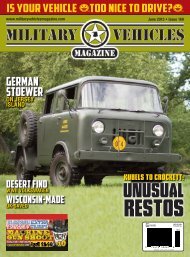

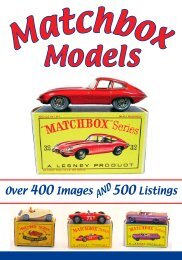

![Index [media2.fwpublications.com] - F+W Media](https://img.yumpu.com/45216355/1/190x245/index-media2fwpublicationscom-f-w-media.jpg?quality=85)



